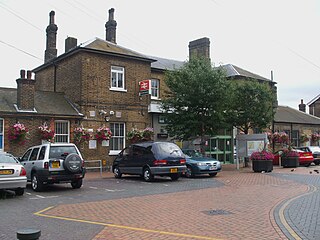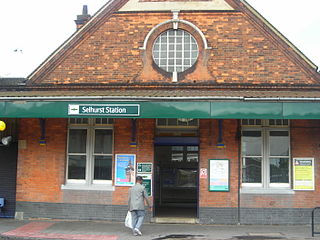
Thameslink is a 24-hour main-line route in the British railway system, running from Bedford, Luton, St Albans City, Peterborough and Cambridge via central London to Sutton, Orpington, Sevenoaks, Rainham, Horsham, Brighton, East Grinstead, and Littlehampton. The network opened as a through service in 1988, with severe overcrowding by 1998, carrying more than 28,000 passengers in the morning peak. All the services are currently operated by Govia Thameslink Railway.

The British Rail Class 317 is an electric multiple unit (EMU) passenger train constructed by British Rail Engineering Limited in two batches, 48 sets being produced in 1981–82 and 24 sets in 1985–87. They were the first of several classes of British Rail EMU to be based on the all-steel Mark 3 bodyshell, departing from the "PEP"-aluminium design which had spawned the earlier Class 313 to Class 315, Class 507 and Class 508. The Mark 3 bodyshell was also the basis of Class 318, Class 455, and the diesel Class 150. The Class 317 uses overhead alternating current electrification.

The British Rail Class 377 Electrostar is a British dual-voltage electric multiple unit passenger train (EMU) built by Bombardier Transportation on its Electrostar platform at Derby Litchurch Lane Works from 2001 to 2014.

Norwood Junction railway station is a National Rail station in South Norwood in the London Borough of Croydon, south London and is in Travelcard Zone 4. It is 8 miles 55 chains down the line from London Bridge.

Selhurst railway station is in the London Borough of Croydon in south London, 9 miles 31 chains (15.1 km) along the line from London Victoria. It is operated by Southern, which also provides all the train services. The station is in Travelcard Zone 4.

Three Bridges railway station is located in and named after the village of Three Bridges, which is now a district of Crawley, West Sussex, England. It is at the point where the Arun Valley Line diverges from the Brighton Main Line and Thameslink, 29 miles 21 chains (47.1 km) down the line from London Bridge via Redhill.

Salfords railway station serves the village of Salfords in Surrey, England. The station is sometimes shown as Salfords (Surrey) in timetables to differentiate it from the two stations in Salford, Greater Manchester. It is on the Brighton Main Line, 23 miles 37 chains (37.8 km) down the line from London Bridge via Redhill and is managed by Southern. Train services are provided by Thameslink and Southern.

Lingfield railway station is on the East Grinstead branch of the Oxted line in southern England and serves Lingfield in Surrey. It is 26 miles 23 chains from London Bridge, although off peak trains run to and from London Victoria. The station is managed by Southern.

The British Rail Class 319 is an electric multiple unit passenger train built by British Rail Engineering Limited's Holgate Road carriage works for use on north–south cross-London services. These dual-voltage trains are capable of operating on 25 kV 50 Hz from AC overhead wires or 750 V DC from a third rail.

Thameslink was a train operating company in the United Kingdom owned by Govia that operated the Thameslink franchise from March 1997 until March 2006. The franchise was due to end on 31 March 2004, but on 13 February 2004 the Strategic Rail Authority awarded Govia a two-year extension.

Glasgow Shields Road ETD is a railway electric traction depot in Glasgow, Scotland. The depot is located on the south side of the Glasgow Central to Paisley lines, adjacent to Shields Junction and close to the site of the former Shields Road station. The depot's code is 'GW'.
The area around Hornsey railway station in Hornsey has been the site of several railway maintenance facilities from the mid 19th century onwards.

The Thameslink Programme, originally Thameslink 2000, was a £6 billion project in south-east England to upgrade and expand the Thameslink rail network to provide new and longer trains between a wider range of stations to the north and to the south of London. The development facilitated new cross-London journeys, which means that passengers no longer have to change trains in London. Work included platform lengthening, station remodelling, new railway infrastructure, and new rolling stock. The project was originally proposed in 1991 following the successful introduction of the initial Thameslink service in 1988. After many delays, planning permission was granted in 2006 and funding was approved in October 2007. Work started in 2009 and was completed on 18 September 2020, although trains over the new routes began running in 2018.

Auckland railway electrification occurred in phases as part of investment in a new infrastructure for Auckland's urban railway network. Electrification of the network had been proposed for several decades. Installation started in the late 2000s after funds were approved from a combination of regional and central government budgets.

The British Rail Class 700 Desiro City is an electric multiple unit passenger train capable of operating on 25 kV 50 Hz AC from overhead wires or 750 V DC from third rail. 115 trainsets were built between 2014 and 2018, for use on the Thameslink network, as part of the Thameslink Programme in the United Kingdom. As of 2021, they are operated by Govia Thameslink Railway.

Cricklewood sidings currently provides stabling for passenger trains, and is the site of a former steam shed and diesel traction maintenance depot located in Cricklewood, Greater London, England. It is situated beside the Midland Main Line, to the east of Cricklewood station.

Chart Leacon Traction and Rolling Stock Maintenance Depot was at one time a railway depot located in Ashford, Kent, England. The depot was situated 1.5 mi (2.4 km) to the west of Ashford International station on the south side of the line to Pluckley railway station.

Selhurst Depot is located in Selhurst, Croydon, England on the Brighton Main Line and is near Selhurst station. The depot code is SU.

Bedford Carriage Sidings are located in Bedford, Bedfordshire, England on the Midland Main Line, near Bedford station.
Three Bridges depot is an Electric Traction Depot located in Three Bridges, West Sussex, England. The depot is about 1.5 km south of Three Bridges railway station, on either side of the Brighton Main Line.



















